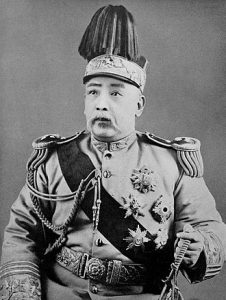Yuan Shikai (traditional Chinese: 袁世凱; simplified Chinese: 袁世凯; pinyin: Yuán Shìkǎi; Wade–Giles: Yüan2 Shih4-k’ai3; 16 September 1859 – 6 June 1916) was a Chinese general and statesman who served as the second provisional president and the first official president of the Republic of China,head of the Beiyang government from 1912 to 1916 and Emperor of China from 1915 to 1916. A major political figure during the late Qing dynasty, he spearheaded a number of major modernisation programs and reforms and played a decisive role in securing the abdication of the Xuantong Emperor in 1912, which marked the collapse of the Qing monarchy and the end of imperial rule in China.In textbooks and popular imagination, Yuan Shikai is often reduced to a power-hungry warlord or the man who “killed the Republic.” But history is rarely black and white—and neither was Yuan—-From Wikipedia

After the Wuchang Uprising in 1911, Yuan didn’t immediately grasp for power. Archival records suggest he responded to the Qing court’s summons with pragmatic military and fiscal proposals to stabilize the crisis (Ding Jian, 2017). His behind-the-scenes diplomacy—like using his son to test British responses or leaking Russian expansion plans—was less about betrayal and more about maintaining national sovereignty in a time of chaos (Ding Jian, 2023).
What really caught my attention was his legacy in education. As governor of Zhili, he transformed ancient academies into modern schools and built China’s first provincial education bureau. Under his leadership, the province had more than 10% of the country’s primary schools by 1906 (Li Zhanping, 2012). That’s not just reform on paper—it’s structural change.
Yuan also understood that modernization needed talent. He supported industrial training, founded technical institutes like Beiyang Gongyi Xuetang (today’s Hebei University of Technology), and even cautiously opened education to women, despite conservative limits. In an age of chaos, these were radical moves.
Of course, Yuan was no saint. He crushed revolutions while claiming to support constitutionalism. He used old networks while running a new republic. But isn’t that exactly what transitional leaders do—walk the line between what is and what could be?
Maybe it’s time to move beyond calling Yuan Shikai either a traitor or a hero. He was both a conservative and a reformer, a man shaped by crisis who shaped modern China more than we give him credit for. Understanding him means understanding that real change is messy—and sometimes comes from the most unlikely hands.
